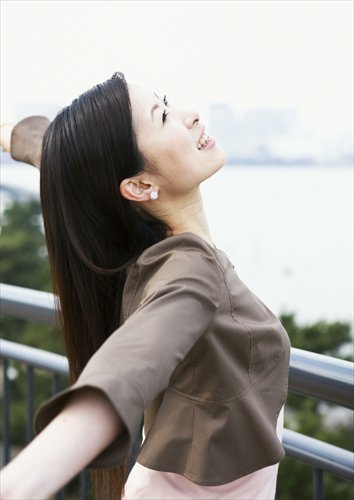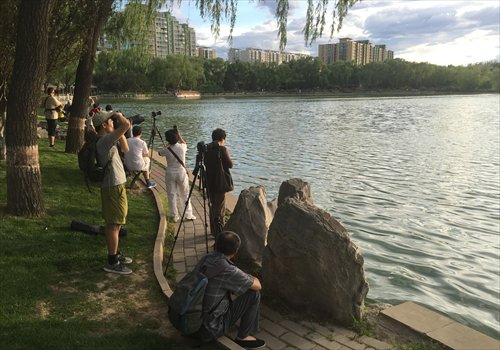Ozone poses new threat
Beijingers buoyed by blue skies, but all is not what it seems

People are reminded to be more mindful of ozone, the primary pollutant in Beijing these days. Photo: IC
It was a clear blue sky over Beijing. White clouds dotted the horizon and it all looked picture perfect. In fact, the beautiful weather last week inspired Beijingers to take thousands of photos which flooded social media.
But all is not what it seems.
Many people are surprised to learn that the pollution hazard still lurks.
"One moment I was thinking about going out to enjoy the outdoors, the next I was worried and decided to stay at home with my air purifier," said Li Jin. She has read in the news that the ozone level is high these days, which apparently also poses serious health risks, just like the dreaded PM2.5 particles.
Between June 1 and 15, the primary pollutant in Beijing has been ozone for eight days, carbon monoxide for three days and PM2.5 particles for one day. The other three days the air was good, according to the daily data of the Ministry of Environmental Protection.
"At first, I only knew that the ozone layer is decreasing and needs to be protected. Up until now, I didn't know ground-level ozone could be bad. People should really learn about the pollutants and take precautions, because it's up to us to protect ourselves," said Li, 32, an administrative staffer at a local education institution.
Ozone alert
Ozone is a toxic gas formed from photochemical reactions in the presence of sunlight and precursor pollutants, such as oxide of nitrogen (NOx) and volatile organic compounds (VOCs). He Xiaoxia, director of Beijing-based non-governmental organization Green Beagle Environment Institute, explained that ozone pollution is largely related to meteorological conditions.
"To put it in simpler terms, high temperature helps form ozone pollution," she said. "When the visibility is poor, people usually consider the level of PM2.5 is high. However, when the weather is good, people should still be alert for ozone pollution, since it easily occurs during seemingly nice weather."
However, He pointed out that the two kinds of pollution do not always work against each other. When one kind is high, the other is not necessarily low. On smoggy days when the level of PM2.5 particles is high and reflects the sunlight, photochemical smog is usually less intense. But the physical and chemical reactions among the different elements in photochemical smog are complicated, and could generate particles too. The components might even change between solid, liquid or gas, said He.
Since the photochemical smog of the 1940s which led to illness and even death in Los Angeles, people's understanding of pollution, including the ozone, has improved. "The formation [of particles] is extremely complicated. At present, we can only explain the basic reactions," said He.
Ozone pollution is largely due to car emissions, which contributes to photochemical smog, so it's usually more severe in big cities like Beijing, He told Metropolitan. However, the level of pollution is also influenced by large-scale atmospheric conditions, like El Nino.
The recent windy, clear weather in Beijing can be attributed to the climatic changes brought on by the El Nino phenomenon.
"By far, the greatest effect of El Nino in China this year has been the heavy rainfall, but it's also possible for it to cause large-scale dryness in just a few days. It's hard to say," said He. The public should be aware of the unpredictability of ozone.

The better and sunnier the day is, the more likely there will be ozone pollution. People with respiratory problems are advised to stay indoors on days like these. Photo: Li Hao/GT
Growing awareness
Given the wide media coverage, people's knowledge of PM2.5 has increased, but many will still subconsciously associate pollution only with PM2.5 particles.
There are multiple indexes for monitoring air quality, including PM2.5 particles, sulfur dioxide, carbon monoxide, formaldehyde, ozone and others. He said although many people don't care about them, they are very important.
"Nowadays, many of the smartphone apps that people use only provide PM2.5 data, that tells them whether the air is good or not, based only on that one factor," said He. "To check whether the air is polluted with PM2.5 particles, people can often just take a look outside and decide whether or not to take precautions, like wearing a mask. But on a sunny day, people might be ignorant of the pollution. It's a common misconception [that the air is not polluted]," said He.
She added that normally, people won't feel grit in their eyes or nose due to ozone pollution, unless the concentration of ozone is high.
Fortunately, there's a growing awareness among Chinese about ozone pollution, according to experts. Data generated by Baidu Index, a data collecting service provided by China's search engine Baidu, shows that the number of searches using the keyword "ozone" has been increasing over the last six months. The frequency of ozone-related searches peaked at the end of May and in early June.
Health hazards
According to the World Health Organization (WHO), daily exposure to ozone of 160 µg/m3 for up to eight hours, is associated with physiological and inflammatory lung effects in healthy, exercising young adults and children. It's also estimated to increase daily mortality by three to five percent, based on time-series evidence.
Long-term exposure to ozone might increase the risk of death from respiratory illness. The results of a study of 450,000 people over 18 years and published in The New England Journal of Medicine in 2009, proves the effect of ozone in the risk of death from respiratory causes. People living in US cities with high ozone levels, such as Houston (Texas) and Los Angeles (California), face a 30 percent increased risk of dying from lung disease.
Liu Zeying, a doctor at Beijing Anzhen Hospital's department of respiratory medicine, said individuals react differently to ozone levels.
"Between ozone and particles, I am not sure which is more harmful. The elements are complicated, and their effects are different depending on each individual's conditions."
Doctors can seldom tell which pollutant is responsible for a patient's respiratory symptoms, said Liu. "It's virtually impossible to tell, unless it's asthma-related and the patient is known to be allergic to some particles."
Liu has warned that those with sensitive respiratory organs, or underlying conditions such as asthma or tracheitis, and those with a family history of such conditions, need to be extra careful.
Indoor dangers
Household ozone generators which are used to sterilize and deodorize, have recently become quite popular on the market, according to Song Guangsheng, secretary of the China Indoor Environmental Monitoring Committee.
A search for "ozone" on China's largest online retailer taobao.com, brings up 20,000 related items, most of which are electronic devices to sterilize fruits and vegetables, kitchenware, underwear and towels, or to get rid of formaldehyde or particles.
But Song warned people to be extra careful when using such devices.
"Always use the timer on the ozone generator and leave the room while it's in operation. Air purifiers that use electrostatic adherence technology might also generate a small amount of ozone, but it's not harmful if the level is below the national standard," said Song.
Song assured people that approved products on the market have been thoroughly checked by quality supervision authorities and are safe for domestic use.
Many people also use ozone generators to sterilize the inside of their vehicles either at car maintenance centers or using portable generators. But Song said it is not advisable to do this too regularly.
"Ozone accelerates the oxidization of metals and rubber [in cars], so don't use it too often or over the long term," he said.
People should also learn about the possible hazards of pollutants lurking in other equipment such as sterilizing units, foot massagers that use ozone to sterilize the water, and even their laser printers.
While ozone in the outdoors is hard for individuals to detect, people will be able to smell an irritant in most circumstances when approaching an ozone-producing device that is emitting more than what is safe, said Song.
Taking precautions
So what precautions can Beijingers take? While He advises people check the real-time ozone level on the Internet or on a smartphone app, Song suggests people avoid outdoor activities between 1 pm and 5 pm, when both the temperature and the ozone level are high.
"Keep the house well ventilated, but don't open windows for air in the hot afternoon," said Song.
In broader terms, the most effective management method would be to control the source, including improving gasoline quality and raising vehicular emission standards, said He.
"On the positive side, Beijing has higher regional standards for car emissions than elsewhere in China," she added.
"Living in Beijing is great but it also means sacrificing many things. But having to learn more about a new kind of pollution is not so bad," said Li.